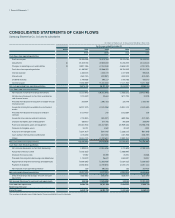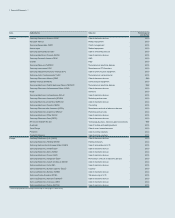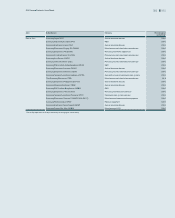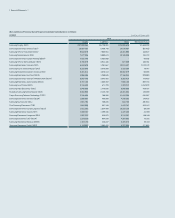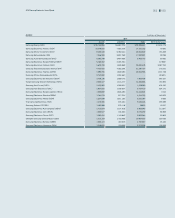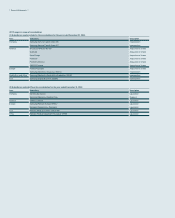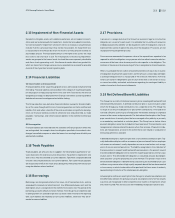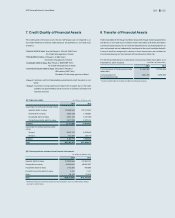Samsung 2014 Annual Report Download - page 58
Download and view the complete annual report
Please find page 58 of the 2014 Samsung annual report below. You can navigate through the pages in the report by either clicking on the pages listed below, or by using the keyword search tool below to find specific information within the annual report.
Financial Statements
(C) Disposal of subsidiaries
If the Group loses control of a subsidiary, any investment continuously retained in
the subsidiary is re-measured at its fair value at the date when control is lost and
any resulting differences are recognized in profit or loss. Such fair value becomes
the initial carrying amount for the subsequent measurement of the retained inter-
est accounted for as an associate, joint venture, or financial asset. In addition, any
amounts previously recognized in other comprehensive income in respect of such
entity are accounted for as if the Group had directly disposed of the related assets
or liabilities. As a result, the previously recognized other comprehensive income
are reclassified into profit or loss.
(D) Non-controlling interests
Each component of profit or loss and other comprehensive income is attributed to
owners of the parent and to non-controlling interests. Total comprehensive income
is attributed to owners of the parent and to non-controlling interests even if this
results in a negative balance of non-controlling interests.
(E) Associates
Associates are all entities over which the Group has significant influence but does
not have control, generally investees of which from 20% to 50% of voting stock is
owned by the Group. Investments in associates are initially recognized at acquisi-
tion cost using the equity method. Unrealized gains on transactions between the
Group and its associates are eliminated to the extent of the Group’s interest in the
associates. If there is any objective evidence that the investment in the associate
is impaired, the Group recognizes the difference between the recoverable amount
of the associate and its book value as impairment loss.
(F) Joint arrangements
A joint arrangement of which two or more parties have joint control is classified as
either a joint operation or a joint venture. A joint operator has rights to the assets,
and obligations for the liabilities, relating to the joint operation and recognizes the
assets, liabilities, revenues and expenses relating to its interest in a joint opera-
tion. A joint venturer has rights to the net assets relating to the joint venture and
accounts for that investment using the equity method.
2.4 Foreign Currency Translation
(A) Functional and presentation currency
Items included in the financial statements of each of the Group’s entities are
measured using the currency of the primary economic environment in which each
entity operates (the “functional currency”). The consolidated financial statements
are presented in Korean won, which is the parent company’s functional and pre-
sentation currency.
(B) Transactions and balances
Foreign currency transactions are translated into the functional currency using the
exchange rates prevailing at the dates of the transactions or valuation where items
are re-measured. Foreign exchange gains and losses resulting from the settle-
ment of such transactions and from the translation at year-end exchange rates of
monetary assets and liabilities denominated in foreign currencies are recognized
in profit or loss.
Exchange differences arising on non-monetary financial assets and liabilities such
as equity instruments at fair value through profit or loss and available-for-sale eq-
uity instruments are recognized in profit or loss and other comprehensive income,
respectively, as part of the fair value gain or loss.
(C) Translation into the presentation currency
The results and financial position of all the foreign entities that have a functional
currency different from the presentation currency of the Group are translated into
the presentation currency as follows:
• Assets and liabilities for each statement of financial position presented are trans-
lated at the closing rate at the end of the reporting date.
• Income and expenses for each statement of income are translated at average
exchange rates, unless this average is not a reasonable approximation of the
cumulative effect of the rates prevailing on the transaction dates, in which case
income and expenses are translated at the rate on the dates of the transactions.
•
All resulting exchange differences are recognized in other comprehensive income.
On consolidation, exchange differences arising from the translation of the net
investment in foreign operations are recognized in other comprehensive income.
When a foreign operation is partially disposed of or sold, the exchange differences
that were recorded in equity are reclassified as part of gains and losses on dispo-
sition in the statement of income. When the Group loses control over foreign sub-
sidiaries, the exchange differences that were recorded in equity are reclassified
into profit or loss when such gain or loss on disposition is recognized.
Any goodwill arising on the acquisition of a foreign operation and any fair value ad-
justments are treated as the foreign operation’s assets and liabilities. Such good-
will is expressed in the foreign operation’s functional currency and is translated
at the closing rate. Exchange differences are recognized in other comprehensive
income.


